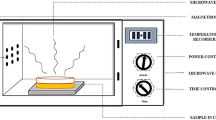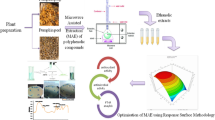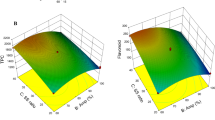Abstract
A microwave-assisted extraction (MAE) procedure to obtain phenolic compounds from carob bark was optimized by using response surface methodology. A four-factor, three-level Box–Behnken design with five central points was used to evaluate the influence of temperature, solid-liquid ratio, ethanol concentration, and time in carob bark extraction in terms of antioxidant activity (DPPH) and total extraction yield. Optimal extraction conditions were found using 80 °C, 35% (v/v) ethanol, a ratio of 35 mL/g, and 29.5 min. Total phenolics content (TPC), antioxidant activity (DPPH, FRAP, ABTS), carbohydrate content, and main polyphenols composition (HPLC) were determined at optimal conditions. An experimental total yield of 66.5% was obtained with a TPC value of 33.6 mg GAE/g DW and polysaccharides content of 345.4 mg glucose/g DW. A high antioxidant activity was also shown by the three methods tested. The results showed the potential of carob pods skin as a natural source of phenolic compounds, in particular gallic acid, and the effectiveness of MAE as extraction technique for the revalorization of this agro-food waste.




Similar content being viewed by others
References
Almanasrah M, Roseiro LB, Bogel-Lukasik R, Carvalheiro F, Brazinha C, Crespo J, Kallioinen M, Mänttäri M, Duarte LC (2015) Selective recovery of phenolic compounds and carbohydrates from carob kibbles using water-based extraction. Ind Crop Prod 70:443–450
Arrieta M, Sessini V, Peponi L, (2017) Biodegradable poly (ester-urethane) incorporated with catechin with shape memory and antioxidant activity for food packaging. Eur Polym J
Bai XL, Yue TL, Yuan YH, Zhang HW (2010) Optimization of microwave-assisted extraction of polyphenols from apple pomace using response surface methodology and HPLC analysis. J Sep Sci 33(23-24):3751–3758
Balaban M (2004) Identification of the main phenolic compounds in wood of Ceratonia siliqua by GC-MS. Phytochem Anal 15(6):385–388
Ballard TS, Mallikarjunan P, Zhou K, O’Keefe S (2010) Microwave-assisted extraction of phenolic antioxidant compounds from peanut skins. Food Chem 120(4):1185–1192
Biner B, Gubbuk H, Karhan M, Aksu M, Pekmezci M (2007) Sugar profiles of the pods of cultivated and wild types of carob bean (Ceratonia siliqua L.) in Turkey. Food Chem 100(4):1453–1455
Bouli AA, Hansali M, Owen RW, (2010) Determination of phenolic composition of carob pods grown in different regions of Morocco. J Nat Prod 3
Chemat F, Cravotto G (2012) Microwave-assisted extraction for bioactive compounds: theory and practice. Springer Science & Business Media.
Dai J, Mumper RJ (2010) Plant phenolics: extraction, analysis and their antioxidant and anticancer properties. Molecules 15(10):7313–7352
Di Donato P, Taurisano V, Tommonaro G, Pasquale V, Jiménez JMS, de Pascual-Teresa S, Poli A, Nicolaus B (2017) Biological properties of polyphenols extracts from agro industry’s wastes. Waste Biomass Valorization, 1-12.
El Ansari Zineb BM, Alain B, Ahmed L (2017) Total polyphenols and gallic acid contents in domesticated carob (Ceratonia siliqua L.) pods and leaves. Int J Pure App Biosci 5(4):22–30
Ferreres F, Grosso C, Gil-Izquierdo A, Valentão P, Mota AT, Andrade PB (2017) Optimization of the recovery of high-value compounds from pitaya fruit by-products using microwave-assisted extraction. Food Chem 230:463–474
Filip S, Pavlić B, Vidović S, Vladić J, Zeković Z (2017) Optimization of microwave-assisted extraction of polyphenolic compounds from Ocimum basilicum by response surface methodology. Food Anal Methods 10(7):2270–2280
Hadrich B, Dimitrov K, Kriaa K, (2017) Modelling investigation and parameters study of polyphenols extraction from carob (Ceratonia siliqua L.) using experimental factorial design. J Food Process Preserv 41(2).
Hayat K, Hussain S, Abbas S, Farooq U, Ding B, Xia S, Jia C, Zhang X, Xia W (2009) Optimized microwave-assisted extraction of phenolic acids from citrus mandarin peels and evaluation of antioxidant activity in vitro. Sep Purif Technol 70(1):63–70
Hu S, Kim B-Y, Baik M-Y (2016) Physicochemical properties and antioxidant capacity of raw, roasted and puffed cacao beans. Food Chem 194:1089–1094
Huma ZE, Jayasena V, Nasar-Abbas SM, Imran M, Khan MK, (2017) Process optimization of polyphenol extraction from carob (Ceratonia siliqua) kibbles using microwave-assisted technique. J Food Process Preserv
Huma ZE, Jayasena V, Nasar-Abbas SM, Imran M, Khan MK (2018) Process optimization of polyphenol extraction from carob (Ceratonia siliqua) kibbles using microwave-assisted technique. J Food Process Preserv 42(2):e13450
Karakaya SE, El SN, Taş AA (2001) Antioxidant activity of some foods containing phenolic compounds. Int J Food Sci Nutr 52(6):501–508
Karami Z, Emam-Djomeh Z, Mirzaee HA, Khomeiri M, Mahoonak AS, Aydani E (2015) Optimization of microwave assisted extraction (MAE) and soxhlet extraction of phenolic compound from licorice root. J Food Sci Technol 52(6):3242–3253
Khlifa M, Bahloul A, Kitane S (2013) Determination of chemical composition of carob pod (Ceratonia siliqua L.) and its morphological study. J Mater Environ Sci 4(3):348–353
Kumar N, Kaur P, Bhatia S, (2017) Advances in bio-nanocomposite materials for food packaging: a review.Nutr Food Sci 47(4)
Kumazawa S, Taniguchi M, Suzuki Y, Shimura M, Kwon M-S, Nakayama T (2002) Antioxidant activity of polyphenols in carob pods. J Agric Food Chem 50(2):373–377
Makris DP, Kefalas P (2004) Carob pods (Ceratonia siliqua L.) as a source of polyphenolic antioxidants. Food Technol Biotechnol 42(2):105–108
Makris DP, Boskou G, Andrikopoulos NK (2007) Polyphenolic content and in vitro antioxidant characteristics of wine industry and other agri-food solid waste extracts. J Food Compos Anal 20(2):125–132
Manousaki A, Jancheva M, Grigorakis S, Makris DP (2016) Extraction of antioxidant phenolics from agri-food waste biomass using a newly designed glycerol-based natural low-transition temperature mixture: a comparison with conventional eco-friendly solvents. Recycling 1(1):194–204
Meziani S, Oomah BD, Zaidi F, Simon-Levert A, Bertrand C, Zaidi-Yahiaoui R (2015) Antibacterial activity of carob (Ceratonia siliqua L.) extracts against phytopathogenic bacteria Pectobacterium atrosepticum. Microb Pathog 78:95–102
Moreira MM, Barroso MF, Boeykens A, Withouck H, Morais S, Delerue-Matos C (2017) Valorization of apple tree wood residues by polyphenols extraction: comparison between conventional and microwave-assisted extraction. Ind Crop Prod 104:210–220
Owis AI, El-Naggar E-MB (2016) Identification and quantification of the major constituents in Egyptian carob extract by liquid chromatography–electrospray ionization-tandem mass spectrometry. Pharmacogn Mag 12(Suppl 1):S1
Pan X, Niu G, Liu H (2003) Microwave-assisted extraction of tea polyphenols and tea caffeine from green tea leaves. Chem Eng Process Process Intensif 42(2):129–133
Papagiannopoulos M, Wollseifen HR, Mellenthin A, Haber B, Galensa R (2004) Identification and quantification of polyphenols in Carob Fruits (Ceratonia siliqua L.) and derived products by HPLC-UV-ESI/MS n. J Agric Food Chem 52(12):3784–3791
Piñeiro Z, Marrufo-Curtido A, Vela C, Palma M (2017) Microwave-assisted extraction of stilbenes from woody vine material. Food Bioprod Process 103:18–26
Pinela J, Prieto M, Carvalho AM, Barreiro MF, Oliveira MBP, Barros L, Ferreira IC (2016) Microwave-assisted extraction of phenolic acids and flavonoids and production of antioxidant ingredients from tomato: a nutraceutical-oriented optimization study. Sep Purif Technol 164:114–124
Rosa R, Tassi L, Orteca G, Saladini M, Villa C, Veronesi P, Leonelli C, Ferrari E (2017) Process intensification by experimental design application to microwave-assisted extraction of phenolic compounds from Juglans regia L. Food Anal Methods 10(3):575–586
Roseiro LB, Duarte LC, Oliveira DL, Roque R, Bernardo-Gil MG, Martins AI, Sepúlveda C, Almeida J, Meireles M, Gírio FM (2013a) Supercritical, ultrasound and conventional extracts from carob (Ceratonia siliqua L.) biomass: effect on the phenolic profile and antiproliferative activity. Ind Crop Prod 47:132–138
Roseiro LB, Tavares CS, Roseiro JC, Rauter AP (2013b) Antioxidants from aqueous decoction of carob pods biomass (Ceretonia siliqua L.): optimisation using response surface methodology and phenolic profile by capillary electrophoresis. Ind Crop Prod 44:119–126
Sęczyk Ł, Świeca M, Gawlik-Dziki U (2016) Effect of carob (Ceratonia siliqua L.) flour on the antioxidant potential, nutritional quality, and sensory characteristics of fortified durum wheat pasta. Food Chem 194:637–642
Song J, Li D, Liu C, Zhang Y (2011) Optimized microwave-assisted extraction of total phenolics (TP) from Ipomoea batatas leaves and its antioxidant activity. Innovative Food Sci Emerg Technol 12(3):282–287
Spigno G, Tramelli L, De Faveri DM (2007) Effects of extraction time, temperature and solvent on concentration and antioxidant activity of grape marc phenolics. J Food Eng 81(1):200–208
Stavrou IJ, Christou A, Kapnissi-Christodoulou CP (2018) Polyphenols in carobs: a review on their composition, antioxidant capacity and cytotoxic effects, and health impact. Food Chem
Tănase EE, Popa VI, Popa ME, Râpă M, Popa O (2016) Biodegradation study of some food packaging biopolymers based on PVA. Bulletin UASVM Animal Science and Biotechnologies 73:1
Tang X, Kumar P, Alavi S, Sandeep K (2012) Recent advances in biopolymers and biopolymer-based nanocomposites for food packaging materials. Crit Rev Food Sci Nutr 52(5):426–442
Tóth ME, Vígh L, Sántha M (2014) Alcohol stress, membranes, and chaperones. Cell Stress Chaperones 19(3):299–309
Turhan I, Tetik N, Aksu M, Karhan M, Certel M (2006) Liquid–solid extraction of soluble solids and total phenolic compounds of carob bean (Ceratonia siliqua L.). J Food Process Eng 29(5):498–507
Uysal S, Zengin G, Aktumsek A, Karatas S (2016) Chemical and biological approaches on nine fruit tree leaves collected from the Mediterranean region of Turkey. J Funct Foods 22:518–532
Valdés A, Vidal L, Beltrán A, Canals A, Garrigós MC (2015) Microwave-assisted extraction of phenolic compounds from almond skin byproducts (prunus amygdalus): a multivariate analysis approach. J Agric Food Chem 63(22):5395–5402
Vourdoubas J, Skoulou VK (2017) Possibilities of upgrading solid underutilized lingo-cellulosic feedstock (carob pods) to liquid bio-fuel: bio-ethanol production and electricity generation in fuel cells-a critical appraisal of the required processes. Studies in Engineering and Technology 4(1):25–34
Yang Z, Zhai W (2010) Optimization of microwave-assisted extraction of anthocyanins from purple corn (Zea mays L.) cob and identification with HPLC–MS. Innovative Food Sci Emerg Technol 11(3):470–476
Zhao C-N, Zhang J-J, Li Y, Meng X, Li H-B (2018) Microwave-assisted extraction of phenolic compounds from Melastoma sanguineum fruit: optimization and identification. Molecules 23(10):2498
Funding
This research was supported by the Spanish Ministry of Science, Innovation and Universities (MICIU) programs MAT2017-84909-C2-2-R and AGL2015-63855-C2-1-R and by the EU H2020 project YPACK (reference number 773872). Quiles-Carrillo wants to thank GV for his FPI grant (ACIF/2016/182) and MECD for his FPU grant (FPU15/03812). Torres-Giner also thank MINECO for his Juan de la Cierva contract (IJCI-2016-29675).
Author information
Authors and Affiliations
Corresponding author
Ethics declarations
Conflict of Interest
Luis Quiles-Carrillo declares that he has no conflict of interest. Cristina Mellinas declares that she has no conflict of interest. Mari Carmen Garrigos declares that she has no conflict of interest. Rafael Balart declares that he has no conflict of interest. Sergio Torres-Giner declares that he has no conflict of interest.
Ethical Approval
This article does not contain any studies with human participants or animals performed by any of the authors.
Informed Consent
Not applicable.
Additional information
Publisher’s Note
Springer Nature remains neutral with regard to jurisdictional claims in published maps and institutional affiliations.
Rights and permissions
About this article
Cite this article
Quiles-Carrillo, L., Mellinas, C., Garrigos, M.C. et al. Optimization of Microwave-Assisted Extraction of Phenolic Compounds with Antioxidant Activity from Carob Pods. Food Anal. Methods 12, 2480–2490 (2019). https://doi.org/10.1007/s12161-019-01596-3
Received:
Accepted:
Published:
Issue Date:
DOI: https://doi.org/10.1007/s12161-019-01596-3




